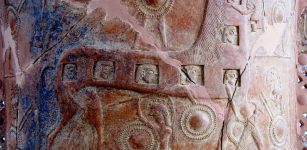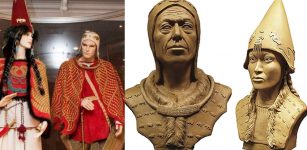Ancient Papyrus Reveals Millennia Old Astronomical Secret: The ‘Demon Star’ Algol Does Exist
A. Sutherland - AncientPages.com - In 1943, an ancient papyrus was bought by the Cairo museum.
It was written in Hieratic and although portions of it were eaten away by ants, it was a very precious ancient document.
The papyrus contained three separate books dealing with astronomy. One of the books was the Cairo Calendar, and now it reveals an ancient astronomical secret.
Papyrus Museum, Cairo, Egypt. The oldest Egyptian calendar. Ancient Egyptians knew about Algol, the Demon Star 3200 years ago.
A research team from Finland is now suggesting that ancient Egyptians were familiar with the Demon Star and its odd behavior already 3200 years ago! Researchers performed a statistical analysis of the Cairo Calendar mythological texts, and their analysis revealed that the periods of Algol and the Moon strongly regulated the actions of deities in this calendar.
The period of the binary star Algol was 2.850 days three millennia ago. The study also confirmed that the brightest phases of Algol and the Moon had particularly positive meanings for the Ancient Egyptians.
For religious reasons, the ancient Egyptians have recorded this period into the Cairo Calendar, which describes the repetitive changes of the Raging one. Cairo Calendar may be the oldest preserved historical document of the discovery of a variable star!
Ancient Egyptian scribes wrote Calendars of Lucky and Unlucky Days that assigned good and bad prognoses for the days of the year. The prognoses were based on mythological and astronomical events considered influential for everyday life.
The best-preserved calendar is the Cairo Calendar (hereafter CC) in papyrus Cairo 86637 dated to 1271-1163 B.C.
Algol is remarkable in many ways.
It seemed to defy the general rule of astrophysics that more massive stars evolve faster because the more massive Algol A has not evolved away from the main sequence, but the less massive Algol B has already evolved to the subgiant stage.
This famous "Algol paradox" was finally resolved only about half a century ago. Algol A was less massive than Algol B when this system was formed.
Algol brightens and dims every 2.867 days, a phenomenon first described in semi-modern western astronomy by John Goodricke, who wrote about what he saw with the naked eye back in 1783.
Although it is highly unlikely the ancient Egyptians could have known that the dimming was caused by one of the binary stars passing in front of the other, they recorded Algol's unusual activity on regular basis. The Demon Star's movements were described in the Cairo Calendar that has managed to survive over thousands of years.
Ancient Egyptians were highly sophisticated astronomers who possessed knowledge that inspired them in their daily lives. Astronomical alignments also played a very important role in the orientation of ancient Egyptian temples.
Written by – A. Sutherland AncientPages.com Senior Staff Writer
Copyright © AncientPages.com. All rights reserved. This material may not be published, broadcast, rewritten or redistributed in whole or part without the express written permission of AncientPages.com.
More From Ancient Pages
-
 Did The Ancient Trojan Horse Really Exist?
Featured Stories | Aug 19, 2015
Did The Ancient Trojan Horse Really Exist?
Featured Stories | Aug 19, 2015 -
 Completely Intact 2,000-Year-Old ‘Chocolatier Style’ Pot Discovered In Mexican Cave
Archaeology | Jul 30, 2022
Completely Intact 2,000-Year-Old ‘Chocolatier Style’ Pot Discovered In Mexican Cave
Archaeology | Jul 30, 2022 -
 Unique Purbeck Marble Found On England’s Oldest Historic Shipwreck
Archaeology | Jun 14, 2024
Unique Purbeck Marble Found On England’s Oldest Historic Shipwreck
Archaeology | Jun 14, 2024 -
 Controversial Ancient Takenouchi Documents Could-Re-Write Our History – Story Of Gods, Lost Continents And Ancient Sages
Featured Stories | Apr 28, 2017
Controversial Ancient Takenouchi Documents Could-Re-Write Our History – Story Of Gods, Lost Continents And Ancient Sages
Featured Stories | Apr 28, 2017 -
 ‘Sophisticated’ 4,000-Year-Old Steppe Pyramid Discovered In Kazakhstan
Archaeology | Aug 12, 2023
‘Sophisticated’ 4,000-Year-Old Steppe Pyramid Discovered In Kazakhstan
Archaeology | Aug 12, 2023 -
 1.3-Million-Year-Old Stone Age Axe Discovered In Morocco Pushes Back The Start Sate Of Acheulian Technology In North Africa
Archaeology | Jul 30, 2021
1.3-Million-Year-Old Stone Age Axe Discovered In Morocco Pushes Back The Start Sate Of Acheulian Technology In North Africa
Archaeology | Jul 30, 2021 -
 First Discovery Of A 127-Million-Year-Old Side-Necked Turtle Fossil In UK
Fossils | Jun 13, 2023
First Discovery Of A 127-Million-Year-Old Side-Necked Turtle Fossil In UK
Fossils | Jun 13, 2023 -
 7,000-Year-Old Tepe Ozbaki Mounds Yielded Valuable Relics – But Now The Site Is In Trouble
Archaeology | Nov 25, 2020
7,000-Year-Old Tepe Ozbaki Mounds Yielded Valuable Relics – But Now The Site Is In Trouble
Archaeology | Nov 25, 2020 -
 Strange Ancient Human Bones And Artifacts Of An Unknown Lost Civilization Found In Nebraska
Featured Stories | Jun 20, 2024
Strange Ancient Human Bones And Artifacts Of An Unknown Lost Civilization Found In Nebraska
Featured Stories | Jun 20, 2024 -
 Giant Blocks For Sphinx-Shaped King Amenhotep III Colossi Uncovered In Luxor, Egypt
Archaeology | Jan 23, 2022
Giant Blocks For Sphinx-Shaped King Amenhotep III Colossi Uncovered In Luxor, Egypt
Archaeology | Jan 23, 2022 -
 Mawangdui Medical Manuscripts: Oldest Surviving Anatomical Atlas In The World
News | Sep 2, 2020
Mawangdui Medical Manuscripts: Oldest Surviving Anatomical Atlas In The World
News | Sep 2, 2020 -
 Mysterious ‘Las Labradas’ Petroglyphs With Roots In The Pre-Columbian Times Of Mexico
Featured Stories | Oct 9, 2020
Mysterious ‘Las Labradas’ Petroglyphs With Roots In The Pre-Columbian Times Of Mexico
Featured Stories | Oct 9, 2020 -
 Secret Ancient Knowledge Of The Druids And The Mystery Of The Missing Library Of Iona
Artifacts | Sep 4, 2016
Secret Ancient Knowledge Of The Druids And The Mystery Of The Missing Library Of Iona
Artifacts | Sep 4, 2016 -
 Scientists Caution Against Over-Interpreting Influence Of Climate On Cultural Change And Catastrophe
Archaeology | Aug 18, 2022
Scientists Caution Against Over-Interpreting Influence Of Climate On Cultural Change And Catastrophe
Archaeology | Aug 18, 2022 -
 Stunning Facial Reconstruction Of ‘Siberian Tutankhamun’ And His ‘Queen’ Who Died 2,600 Years Ago
Archaeology | Jan 12, 2021
Stunning Facial Reconstruction Of ‘Siberian Tutankhamun’ And His ‘Queen’ Who Died 2,600 Years Ago
Archaeology | Jan 12, 2021 -
 On This Day In History: Mesoamerican Long Count Calendar Begins – On August 11, 3114 B.C
News | Aug 11, 2016
On This Day In History: Mesoamerican Long Count Calendar Begins – On August 11, 3114 B.C
News | Aug 11, 2016 -
 2,000-Year-Old Roman Sandal With Nails Found In Germany
Archaeology | Jun 28, 2024
2,000-Year-Old Roman Sandal With Nails Found In Germany
Archaeology | Jun 28, 2024 -
 La Malinche – Greatest Traitor Or A Victim Of Hideous Circumstances?
Featured Stories | Jun 16, 2020
La Malinche – Greatest Traitor Or A Victim Of Hideous Circumstances?
Featured Stories | Jun 16, 2020 -
 Roman-Era Female Statue Dated Back To 1,800 Years Ago Unearthed In Anemurium, Türkiye
Archaeology | Nov 14, 2023
Roman-Era Female Statue Dated Back To 1,800 Years Ago Unearthed In Anemurium, Türkiye
Archaeology | Nov 14, 2023 -
 Mysterious Advanced Underground Civilization And A Secret Society – Technology, History, Language And Goals – Part 2
Civilizations | Apr 23, 2018
Mysterious Advanced Underground Civilization And A Secret Society – Technology, History, Language And Goals – Part 2
Civilizations | Apr 23, 2018

